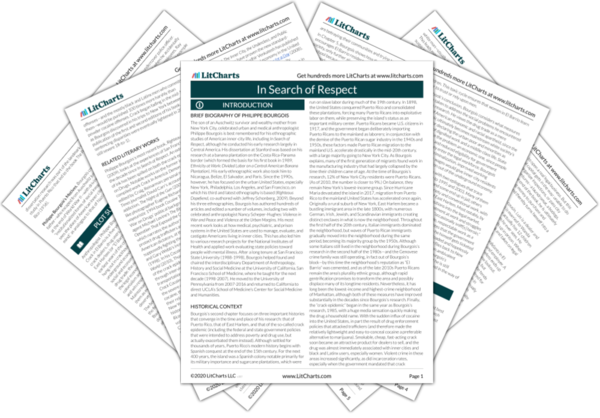Crack Quotes in In Search of Respect
Cocaine and crack, in particular during the mid-1980s and through the early 1990s, followed by heroin in the mid-1990s, have been the fastest growing—if not the only—equal opportunity employers of men in Harlem. Retail drug sales easily outcompete other income-generating opportunities, whether legal or illegal.
The street in front of my tenement was not atypical, and within a two block radius I could—and still can, as of this final draft—obtain heroin, crack, powder cocaine, hypodermic needles, methadone, Valium, angel dust, marijuana, mescaline, bootleg alcohol, and tobacco. Within one hundred yards of my stoop there were three competing crackhouses selling vials at two, three, and five dollars.
It is only the omnipresent danger, the high profit margin, and the desperate tone of addiction that prevent crack dealing from becoming overwhelmingly routine and tedious.
In the five years that I knew Primo he must have made tens of thousands of hand-to-hand crack sales; more than a million dollars probably passed through his fingers. Despite this intense activity, however, he was only arrested twice, and only two other sellers at the Game Room were arrested during this same period. No dealer was ever caught at Ray’s other crackhouses, not even at the Social Club on La Farmacia’s corner, even though its business was brisker.
Contrary to my expectations, most of the dealers had not completely withdrawn from the legal economy. On the contrary—as I have shown in Chapter 3, in discussing the jobs that Willie and Benzie left to become crack dealers and addicts—they are precariously perched on the edge of the legal economy. Their poverty remains their only constant as they alternate between street-level crack dealing and just-above-minimum wage legal employment. The working-class jobs they manage to find are objectively recognized to be among the least desirable in U.S. society; hence the following list of just a few of the jobs held by some of the Game Room regulars during the years I knew them: unlicensed asbestos remover, home attendant, street-corner flyer distributor, deep-fat fry cook, and night-shift security guard on the violent ward at the municipal hospital for the criminally insane.
Substance abuse is perhaps the dimension of inner-city poverty most susceptible to short-term policy intervention. In part, this is because drugs are not the root of the problems presented in these pages; they are the epiphenomenonal expression of deeper, structural dilemmas. Self-destructive addiction is merely the medium for desperate people to internalize their frustration, resistance, and powerlessness. In other words, we can safely ignore the drug hysterias that periodically sweep through the United States. Instead we should focus our ethical concerns and political energies on the contradictions posed by the persistence of inner-city poverty in the midst of extraordinary opulence. In the same vein, we need to recognize and dismantle the class- and ethnic-based apartheids that riddle the U.S. landscape.












